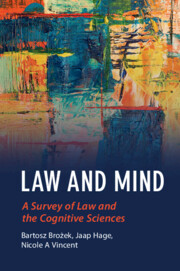Book contents
- Law and Mind
- Law and the Cognitive Sciences
- Law and Mind
- Copyright page
- Contents
- Figures
- Contributors
- Acknowledgements
- 1 Introduction
- I Metatheory and Methodology
- II Ontology and Epistemology
- III Legal Doctrine and Cognitive Sciences
- IV Evidence
- 17 Implications of Neurotechnology: Brain Recording and Intervention
- 18 Neuroimaging Evidence in US Courts
- 19 Neuroscientific Evidence in Context
- 20 Some Issues in Interpreting Neuroscientific Evidence
- 21 Explanation-Based Approaches to Reasoning about Evidence and Proof in Criminal Trials
- V Dissenting Opinions
- References
18 - Neuroimaging Evidence in US Courts
from IV - Evidence
Published online by Cambridge University Press: 21 April 2021
- Law and Mind
- Law and the Cognitive Sciences
- Law and Mind
- Copyright page
- Contents
- Figures
- Contributors
- Acknowledgements
- 1 Introduction
- I Metatheory and Methodology
- II Ontology and Epistemology
- III Legal Doctrine and Cognitive Sciences
- IV Evidence
- 17 Implications of Neurotechnology: Brain Recording and Intervention
- 18 Neuroimaging Evidence in US Courts
- 19 Neuroscientific Evidence in Context
- 20 Some Issues in Interpreting Neuroscientific Evidence
- 21 Explanation-Based Approaches to Reasoning about Evidence and Proof in Criminal Trials
- V Dissenting Opinions
- References
Summary
This chapter provides a detailed consideration of neuroscience and neuroimaging evidence (collectively termed “neuroimaging evidence”) in US federal and state courts. While essentially an explanation of the law and science, the chapter also details ongoing concerns about neuroimaging evidence: issues related to the quality of the underlying science; the potential for an inferential leap from data to courtroom evidence; the lack of recognized clinical use of some neuroimaging technologies; and the problems of appropriate expertise.
The chapter includes several sections. First, it explains the types of neuroimaging that have been used (or excluded) in court, highlighting the foundational concerns about the studies in general and as applied. Second, it addresses the relevant rules of evidence and critical cases that shape courts’ approach to neuroscience evidence. Substantively, the chapter reviews a variety of criminal and, to a lesser extent, civil matters related to neuroimaging evidence. With respect to criminal law, the chapter explores questions of legal competency, insanity and legal responsibility, sentencing, psychopathy, claims of ineffective assistance of counsel, and neuroscience lie detection. In addition, the chapter examines the special role that neuroscience has played in the development of juvenile sentencing law. The civil section addresses neuroimaging in relationship to traumatic brain injury. Finally, the chapter considers some of the overarching concerns and potential promises about neuroimaging evidence, urging that more co-creation of standards between scientists and the legal profession take place in order to improve the quality of the neuroimaging evidence in court.
- Type
- Chapter
- Information
- Law and MindA Survey of Law and the Cognitive Sciences, pp. 370 - 411Publisher: Cambridge University PressPrint publication year: 2021



